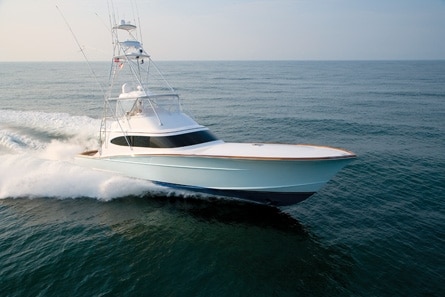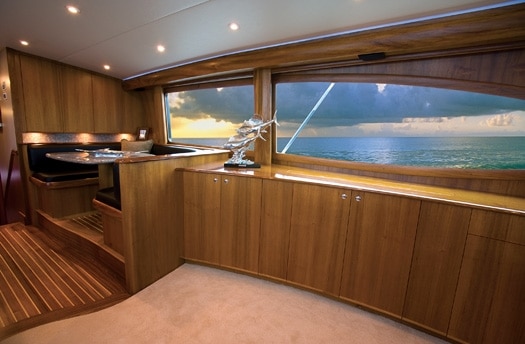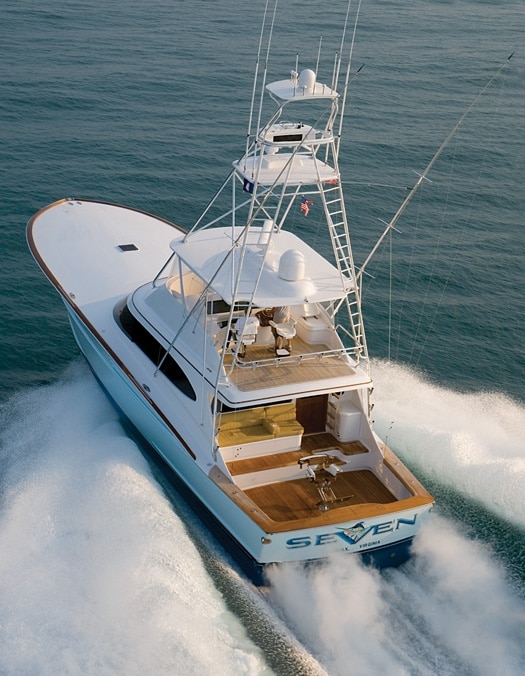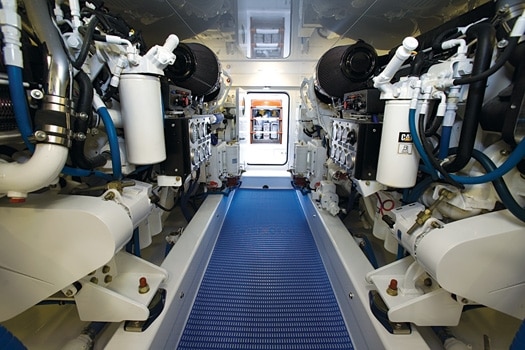
ytgregmay08bayliss68.jpg
The dockside debate over just who builds the best custom fish boats is endless and often heated, usually splitting between South Florida and North Carolina. These competitive, creative boatbuilding centers were once defined by the needs and styles of the anglers in their respective markets. Today the playing field has leveled as the best bite is distant, and anglers are willing to spend what it takes to reach the fish. Savvy production convertible builders now keep a watchful eye on these active custom builders, who manage to spawn new ideas in their small runs and raise the bar throughout this entire category.
It was during this evolution that John Bayliss of Bayliss Boatworks came up through the ranks. Like so many watermen on North Carolina’s Outer Banks, his relationship with the sea began as a mate on a charter boat. At 23 he bought his own boat and later fished production boats competitively, wandering as far as the Bahamas and Mexico. As a result, Bayliss is a very good fisherman and a perfectionist. I know this having served as an angler in his cockpit one morning, scoring nine out of 13 sailfish. I am certain John would have preferred a stronger effort on my part, but he offered praise just the same.
It was Bayliss’s patient manner and eye for detail that first impressed Gardner Britt, the owner of the Bayliss 68 Seven. Bayliss’s success on the tournament circuit was the only calling card Britt needed. When he heard that Bayliss was building custom boats he decided to have a look. “I visited the yard and liked what I saw and I liked John.” Within a week Britt had signed up for Bayliss’s eighth hull. Seven, named for Britt’s seven sons, was delivered 20 months later, on time and on budget-an uncommon achievement in the world of true custom boatbuilding. “Building a boat is not an easy thing to do… it’s a very expensive thing to do and you gotta feel good about the builder,” said Britt. “John and I are better friends now than we were when we started the boat.”

| | |
I can understand why Britt is pleased. Seven is beautifully crafted and has one of the more satisfying profiles I have seen in some time. Bayliss developed her styling with the help of naval architect Robert Ullberg. “We spent a lot of time on paper to get the look we wanted,” said Bayliss. The investment paid off. Her sweeping sheer provides a graceful link between her rakish stem and the gentle tumblehome of her topsides aft. Forward, she has modest flam-excuse me-that’s how one says “Carolina flare” in the regional vernacular. I say modest as a compliment for I find excessive amounts of flam a bit over the top. Flam is the turn of the forward sections near the sheer. On some Carolina boats it is ledge-like and while I suspect this is the “more is better” mantra in play, the shape was likely favored as it shed water in the days prior to effective chine designs. The soft radius of her house and fly-bridge faces blend evenly with her house sides and there is not a straight line to be found. Even the intersection of the house side and side deck are softened with a flawlessly faired radius. I note this with respect, as compound curves are not so easily achieved in wood. The result is simply stunning!
The soft corners and curves of Seven’s exterior lines are carried throughout her design. The shapely console on her teak-soled bridge is a perfect example. While it would be far easier to develop a layout from simple shapes, Bayliss is clearly not fond of the T-square. The pleasant and practical absence of hard corners is in harmony with traditional no-nonsense, sportfish fashion. Helm and companion seating face a swing-up electronics bay and a varnished teak helm pod is fitted with polished stainless steel controls. The console incorporates a freezer and a drink box that can be used as a freezer for long trips. There is a spot for life jackets and a life raft beneath the bench seating. Fore-and-aft bench seating has custom-fitted stowage for a complement of sailfish rods and a removable seatback can be installed to accommodate an observer. The bridge ladder faces outboard, which makes it easier to hang onto in a beam sea. Drains and gutters on the bridge side help keep rain or seawater from spilling back into the cockpit or streaking down the house side.

| | |
A Release Marine fighting chair resides center stage in the teaksoled cockpit. An offset pedestal keeps the angler’s line clear of the corners of the teak covering boards. An in-sole icebox is replenished by an ice machine. This clean ice can then be transferred to an in-transom fish box that can also serve as a livewell. The mezzanine offers a compartment beneath the upper berth in the guest cabin. Bayliss Boatworks dedicates a crew of 45 craftsmen to the construction of two or three boats at a time at its purpose-built facility in Wanchese, North Carolina. The cold-molded wood construction method used to build Seven is typical of Bayliss’s output and is more or less the standard in this niche market. Built on a disposable jig, her bottom is skinned with triple diagonal okoume and supported with laminated-fir longitudinal stringers. Foam coring is used to lighten her marine plywood bulkheads and web frames. Her foredeck, house and bridge are built of an okoume and foam sandwich. All interior and exterior surfaces are covered with fiberglass and faired and finished with Awlgrip. The net result is a strong, lightweight structure.
During our sea trial, I recorded a maximum speed of 40.7 knots. While winds were light and seas calm, Seven’s captain Keith Greenberg offered praise for her performance in challenging conditions. This would be in line with the experience I have had with other Robert Ullberg hull forms. Seven has a moderate entry, slightly convex sections and 13 degrees of deadrise at the transom. Shallow propeller pockets lower shaft angle and trim draft a bit. Greenberg typically cruises at 1950 rpm, which during our sea trial yielded 33.8 knots and a fuel burn of 112 gallons per hour. Her pair of 1,825-horsepower Caterpillars provided clean, even acceleration. She exhibited no excessive bow rise and I found the tabs necessary only for athwartships trim. While large boats can be a handful when fighting fish, Seven has plenty of power and her Release Marine single-lever controls incorporate bow-thruster control buttons. Typically these are simply on or off, but Bayliss managed to devise a system that allows proportional control of the 15-horsepower thruster-nice! I also like tournament-style controls as their length makes them less sensitive than the stubby units that are commonly offered with electronic engines.

| | |
Skilled captains that evolve into skilled boatbuilders are a commodity. Bayliss seems to have logged every shortcoming of every boat he ever served on and addressed them all in the design of Seven. While she is a custom boat built to satisfy an experienced angler, she is also a reflection of John Bayliss, a man who loves fishing and running boats and clearly loves building them. Those in the know will find their way to Bayliss-the customers already have. With orders for 12 boats already, John Bayliss won’t have much time for fishing!
Bayliss Boatworks, (252) 473-9797; www.baylissboatworks.com









